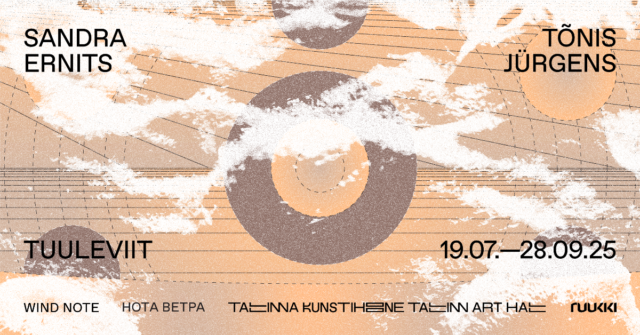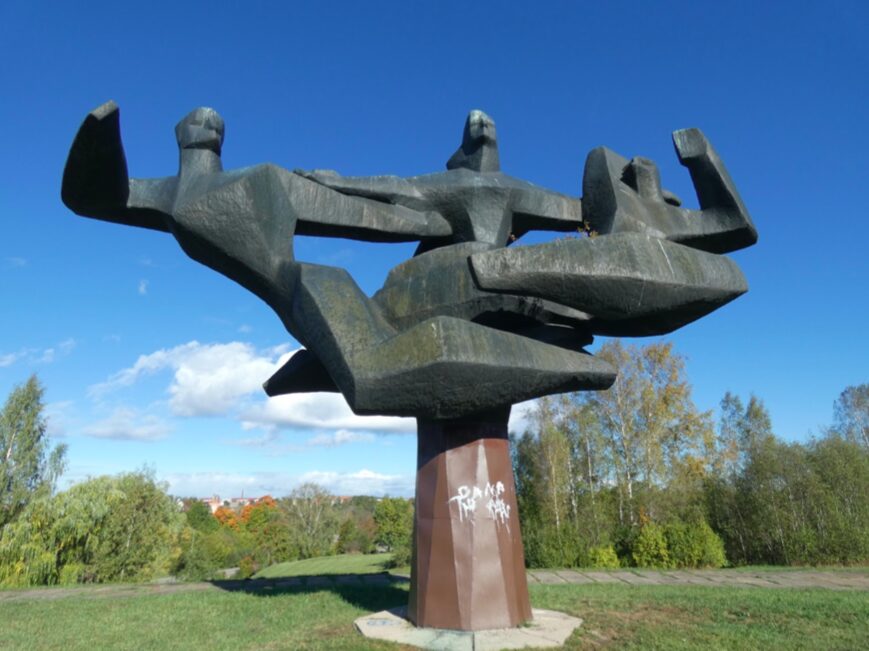The exhibition ‘Town at Edge of Garden at Edge of Town’ presents two Amsterdam-based artists, Evita Vasiljeva and Dan Walwin, working between their home countries of Latvia and the UK respectively. Their first show together was at the POST gallery, on the fifth floor of an office building, tucked away in an inner yard in the centre of Kaunas. This event is a continuation of the collaborative efforts between the Amsterdam-based exhibition space P/////AKT and the curator Audrius Pocius, who last year presented the duo show there ‘Today is the Color Day Meets at Day’ by Antanas Gerlikas and Laura Kaminskaitė.
The exhibition itself is encapsulated in a notion of cinematic process, exploring the differential makings of narrativity between objective and subjective worlds.
‘And there, between the two pictures, there’s an epiphany, an invisible picture. The process is very complicated because you have images running, on the one hand, and at the same time you have contrasts, pauses, and contradictions between these images. After a while, the spectator begins to produce his or her own images through the images that appear on screen, and then there is a second film. This is the real film.’[1]
This quote is from the esteemed filmmaker Alexander Kluge, in an interview conducted by Alexander Thomas. The extract frames the opening thought for the exhibition as a dissection of the meaning of montage. As the basis of cinematography, montage is a process to bridge the contrasts and contradictions serving as the architecture of a film. The question leads into an invitation to the viewer to navigate the exhibition through this notion, too, following peripatetic trajectories in-between the objects, and finding the exhibition in the spectator’s (their own) head. And for Kluge, it is there, and not on the screen, that cinema exists. Placing the focus on the subjectivity of the viewer from the materiality of the film, the constructed space is open to collapse and new realities that arise from it, from the exhibition as a site of tension and disjunction.
In his work, Walwin builds up a variety of overlapping layers of structural logic behind it. In the video Mission place (2019), presented in this exhibition, a mute bell is dragged through sand and water and air, with palm trees in sight; alternatively, the sound of clanging bells fills an unnamed, densely inhabited urban area. The fragmented images are accompanied by sequences of shots of decaying urban structures, the remains of construction sites being swallowed up by unrelenting nature, with glimpses of some personal memorabilia appearing. No clear narrativity is proposed, the viewer being rather lost between the scattered points to focus and defocus on, trusting the perspective of a trembling eye to lead the story. In a recent interview about his solo show at the Centre for Contemporary Arts in Prague, with this work also on display there, the artist confessed to applying the ‘logic of making an exhibition within videos’,[2] raising a curious echo with the notion of the exhibition as a montage, or vice versa, as proposed here in ‘Town at Edge …’. Following the understanding of montage to bridge the contradictory, Walwin is no stranger to building up his film language on this notion. He leans on interplay and disjunction between eerie silences and dense imagery, or between striking sounds and the calmness in sight, and this is where the ‘exhibition’ appears in this confusion between the ear and the eye.
 Another particular layer is unearthed in Walwin’s likening of working in the physical and virtual space of the exhibition to tending a garden. For the artist, the garden, in one way, is where the visitor gives up decision-making; a garden is conceived as a regulated, human-inhabited system with spontaneous and out-of-control elements externally brought in, and this is the flashpoint where things actually start to grow. And this moment between inception and eradication is where the works of Walwin and Vasiljeva meet in this exhibition, in this uninhabited space of becoming; in the uneasy eyes of the collapse of time.
Another particular layer is unearthed in Walwin’s likening of working in the physical and virtual space of the exhibition to tending a garden. For the artist, the garden, in one way, is where the visitor gives up decision-making; a garden is conceived as a regulated, human-inhabited system with spontaneous and out-of-control elements externally brought in, and this is the flashpoint where things actually start to grow. And this moment between inception and eradication is where the works of Walwin and Vasiljeva meet in this exhibition, in this uninhabited space of becoming; in the uneasy eyes of the collapse of time.
Not entirely a light-hearted walk, as it seems at first, leads to Vasiljeva’s speculative abandoned cityscapes, built from concrete structures If Told Correctly, It Will Center On Me (2019). As grand as lightweight, two hexagonal objects resting on steel tubes and wooden plaques bearing barely readable parts of a sentence, they induce sorts of haptic materiality on observing the porous, unpolished surface with clear traces of production. To face the front of the sculptures, the visitor has to lean and crouch in order to get through the spider-like armature sticking out of the concrete, the action producing unexpected noise perturbations, such as in Walwin’s work, when steel is put together. The use of the described materials might appear even slightly fetishistic in the context of Kaunas, a city in recent years having been subjected to the construction of its social agency through its materially based modernist past, the specific urban architecture making up much of the city. For Vasiljeva, concrete and armature is a recurring line in her work, and it has found its surroundings this time as well, inducing here a feeling of being a stranger to familiar lands, much as a distanced wanderer in material decay; the sense of the latter is heightened knowing that the concrete structures were built to be destroyed soon after the exhibition, in an action pertinent to the artist.
Albeit juxtaposed through differing choices of media, both artists share the imagery of a strange land; both their names appear under paper-based collages glued on the gallery’s walls, connecting separate rooms occupied by the artists. Contact Sheets (2019) appears as flickers of interjected film, distorted and melted into a mesh of cars, clothing, construction sites, production-in-progress, and whatever. Vasiljeva’s signature blue is scattered in the empty frames on one wall, as well as supporting the black and white imagery the other. The secret sleep of cinema described by Bradley Eros comes to mind. It is an involuntary act of creating alternative plots and aesthetics of film, extracted from the common effect of movie-goers dozing off in the middle of a movie, and, when woken, interweaving the missed narratives in-between the images. Creating new plots out of a self-interjected parade of images, Eros calls this a participatory augmentation of film art, indulging in the ephemeral construction of reality, not unlike engaging in a sense of montage in the exhibition. Simultaneous shots in Contact Sheets emerge as an alternative plot in the unmaking, confining the flow of images into a space of passing memory.
As Kluge in a beautiful sense describes later on in the same interview with Alexander Thomas, montage as a principle, not a technique, ‘serves to acknowledge the contradictions in the world, the diversity, the plurality in the world’.[3] To visit the town at the edge of the garden at the edge of the town is to accept the world-making in a montage, thus, using Kluge’s words, to embrace the uneasiness of in-between, to concentrate and deconcentrate at the same moment, to make an algorithm where an anti-algorithm is always to be found.
 The exhibition ‘Town at Edge of Garden at Edge of Town’ was shown at the POST gallery between 15 September and 13 October 2019.
The exhibition ‘Town at Edge of Garden at Edge of Town’ was shown at the POST gallery between 15 September and 13 October 2019.
Full photo documentation here
[1] http://thirdrailquarterly.org/alexander-kluge/
[2] https://cca.fcca.cz/en/galleries/cursor-gallery/2/dan-walwin-true-place/





























